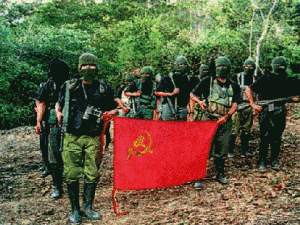A tactical manual attributed to Peru’s Shining Path guerrilla group sets out tighter security protocols and calls for targeted attacks on their critics, in what is likely an effort to prevent government forces taking out more of the group’s leaders, following recent losses.
In a document obtained by the television news program Panorama (see video below), Shining Path leaders Jorge and Victor Quispe Palomino, aliases “Raul” and “Jose,” order the “selective annihilation” of journalists and others who publicly criticize the group. They call for the murder of lawyers representing Abimael Guzman, the imprisoned founder of the Shining Path, who their faction consider to be a traitor. The leaders also call for attacks on electricity towers and the Camisea gas pipeline.
The document, entitled “Combatant Manual of the Heroic and Militarized Communist Party of Peru,” also stipulates new security protocols. According to Panorama, the manual orders guerrillas to communicate using varying dialects, which an analyst consulted by the program said refers to the indigenous language Quechua, and to send written messages rather than voice messages. In addition, the document orders members of the group to cut ties to their families, and change locations within three hours of spotting a surveillance plane.
InSight Crime Analysis
Shining Path leaders are likely revising their tactics and security protocols following the deaths of high-level operatives Orlando Alejandro Borda Casafranca, alias “Alipio,” and Marco Antonio Quispe Palomino, alias “Gabriel,” who were killed by security forces in 2013 with the alleged help of a former ally turned police informant. The new security protocols stipulated in the manual seem designed to prevent future leaks of information to the security forces, and protect the group’s remaining leadership from government operations.
The manual does not appear to mention the group’s involvement in the drug trade. The Shining Path faction led by the Quispe Palomino brothers and based in the Apurimac, Ene and Mantaro River Valley (VRAEM) region gains significant funds by taxing coca growers and charging protection fees from drug traffickers in the form of money, weapons, and equipment. Protecting these interests is likely another purpose of the protocols.
SEE ALSO: Shining Path News and Profile
The other faction of the Shining Path, which is based in the Upper Huallaga Valley, was severely weakened by the 2012 arrest of leader Florindo Eleuterio Flores Hala, alias “Comrade Artemio.” Senior police and US Embassy officials involved in drug eradication efforts in Peru told InSight Crime that eradication efforts in the Huallaga region — where they had previously been unable to make much progress — had improved immensely since Artemio’s capture.


